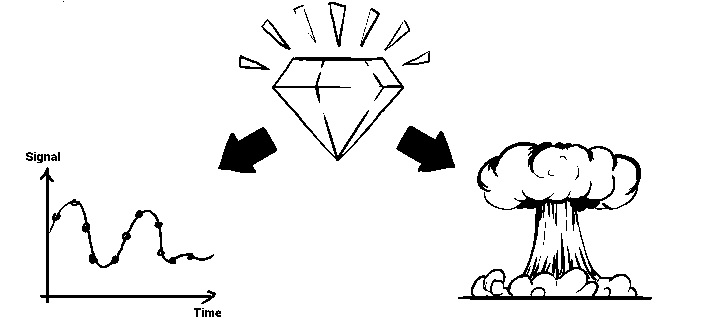
14 Oct How to think about diamonds, differently.
A different perspective
Most of us think about diamonds as a precious gem, hard, with high refractive index and perhaps a good investment (EU thinks so as well, hence, our research grants). Today, diamonds find a variety of uses, in cutting industry, bijouterie, and as radiation and heat shields in modern space probes. A rather unrelated use can be found in modern quantum optics labs-this is how we think of diamonds-as the host material for one of the most precise and responsive quantum sensor. Talking of quantum sensor, these devices/technology make use of the bizarre quantum properties of small atom-scale particles for sensing purposes.
Diamond has impurities (carbon atom replaced with a non-carbon atom) and a vacancy (missing carbon atom). These vacancies often act as a trap for electrons, and these electrons in the vacancy have extraordinary sensitivity towards external changes in magnetic/electric fields and temperature. To put this in practice we need to address individual vacancies in diamond, or sometimes a bunch of them. There are sophisticated techniques to artificially grow these diamonds with suitable properties and sizes (preferably small), but the very first nanodiamonds (one millionth of a millimeter in size) were obtained with brute force. Natural diamonds are in abundance in Russia, so what do they do with it? Well, they put them with explosives in a closed chamber and press the button, this produces very fine diamond particles, and this is how the very first tiny diamonds were produced, and are known as detonation nanodiamonds.
Diamonds in the lab
Now back in the lab again, quantum physicists are putting their knowledge in practice to use the diamonds, and its defects for interacting and sensing different physical parameters (primarily magnetic fields at an unprecedented small scale). Specifically put, lasers are used to bring the electrons in the vacancies into a specific state (we choose to call it the “ground state”) and microwaves are used to manipulate the state of these electrons in order to quantify and control the external perturbation by its effect on the state of the electron. Loosely speaking, electrons here play the role of a small compass that responds to the change in external fields. Rather complicated nuclear magnetic resonance techniques are employed for a diverse range of measurement using this small compass. The single defect centers, in addition, offer high spatial resolution; a very useful property for nanoscale imaging. So, an ideal diamond for a quantum physicist in the lab is the one that has been fabricated with desired defect centers with suitable properties, such that it responds in the desired way to the lasers and microwaves and its interaction with the external field (Magnetic fields usually denoted by letter B) of interest is reflected in the light that it eventually emitted by the diamond. In its beauty, this diamond-based technology relies on complex material fabrication, advance electronic devices, lasers, and a multi-step experiment. It everything goes well; we see the desired signal in light photons coming from the diamond, more often than not.

Going a step further
To enhance the efficiency and the sensitivity of these small sensors even further, ‘’optimized’’ microwave pulses are used to play around with the electron in the defect centers in diamond. This is where quantum optimal control appears. Ample of optimization algorithms come handy in this particular case. It is a fad to have unusual names for these algorithms. There is GRAPE, CRAB, and GOAT (and it is not Lionel Messi or Cristiano Ronaldo for a change). Technically, these algorithms aim to converge to an extremum; the maximum of the minimum of the desired quantity. In the case of quantum sensing this extremum search may be for the best possible sensitivity or most efficient transfer of the electron from one state to another. These optimizations can be sought either by performing a gradient based search or a simple search. Loosely speaking, these search algorithms are like trying to climb up or down the hill (Control landscape in our case), but rather blindfolded, one can follow the steepest slope (gradient) for instance, and technically call it gradient search. The product of this optimization is a microwave pulse, which can have rather peculiar shapes and make the electron go jolly. Implementing optimized microwave pulses to control the sensors results in enhanced sensitivity and improved robustness towards experimental imperfections. We might not have enough power or might be driving our spins (official term for our tiny compass) are slightly wrong frequencies, or might have imperfections in our devices, optimized pulses are meant to tidy up the things for us. Although this may not be the most aesthetic use of diamonds, prospects of it being the next-generation quantum sensors make diamonds even more precious.
– Nimba Oshnik
nimba.pandey@physik.uni-saarland.de
nmba@rhrk.uni-kl.de


